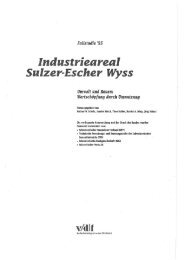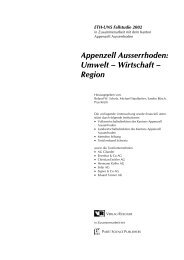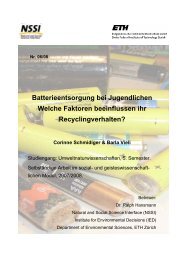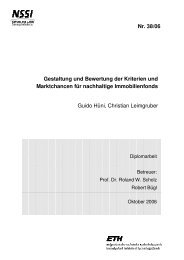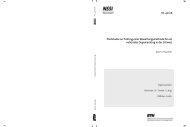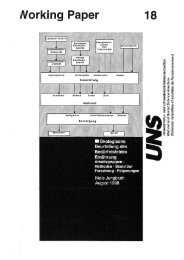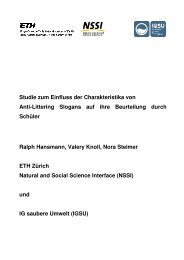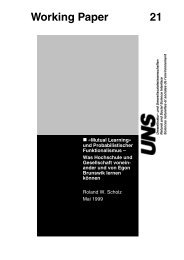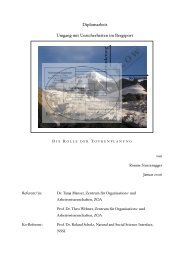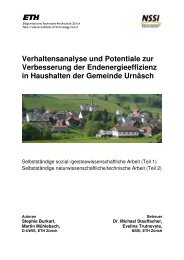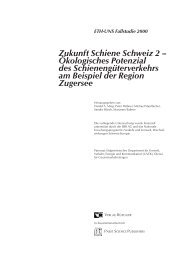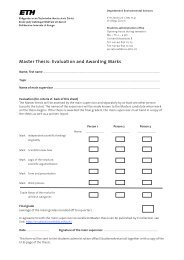Non-road fuel consumption and pollutant emissions ... - BAFU - CH
Non-road fuel consumption and pollutant emissions ... - BAFU - CH
Non-road fuel consumption and pollutant emissions ... - BAFU - CH
Create successful ePaper yourself
Turn your PDF publications into a flip-book with our unique Google optimized e-Paper software.
9 > Supplementary observations 111<br />
9.3.5 Emissions<br />
In Report 49, <strong>emissions</strong> are shown at two levels in two different scenarios. Scenario 1<br />
is based on the assumption that no regulations governing maximum emission levels<br />
enter into effect for non-<strong>road</strong> machines. In Scenario 2, initial assumptions have already<br />
been made concerning the possible introduction of emission limit values. Figure 55<br />
shows the calculations for both scenarios. The <strong>pollutant</strong> <strong>emissions</strong> as per scenario 2 are<br />
of course lower than those for scenario 1.<br />
Most of the differences between the new calculations <strong>and</strong> the data cited in Report 49<br />
result from the changed assumptions regarding inventories <strong>and</strong> operating hours (see<br />
section 9.3.1) <strong>and</strong> the modified emission factors for diesel engines, especially relating<br />
to PM <strong>emissions</strong>. The reasons for the differences in the four main categories (construction,<br />
industrial, agricultural machinery <strong>and</strong> garden/hobby appliances) are explained<br />
briefly below.<br />
In the construction machinery category, the differences between the two reports in<br />
terms of data relating to inventory <strong>and</strong> operating hours as well as <strong>fuel</strong> <strong>consumption</strong> also<br />
apply to <strong>emissions</strong>, with the exception of carbon monoxide <strong>and</strong> particulate matter. In<br />
the case of the latter, the difference (approximately 70% lower level of PM <strong>emissions</strong><br />
versus scenario 2), is attributable to the new emission factors which are lower for older<br />
machines in the new calculation model (see Tab. 14). In the new calculation the carbon<br />
monoxide <strong>emissions</strong> are higher. This is primarily attributable to appliances that were<br />
not included in the inventory <strong>and</strong> operating hours in Report 49.<br />
Carbon monoxide <strong>and</strong> hydrocarbon <strong>emissions</strong> from industrial machinery are significantly<br />
lower than in previous calculations, even though the assumed operating hours<br />
are higher in the new calculations. This increase is attributable to the inclusion of<br />
forklifts <strong>and</strong> snow groomers in the new report, which have low <strong>emissions</strong> of carbon<br />
monoxide <strong>and</strong> hydrocarbons since they are primarily <strong>fuel</strong>led by diesel <strong>and</strong> gas. The<br />
decrease in carbon monoxide <strong>and</strong> hydrocarbon <strong>emissions</strong> can be explained by the<br />
number of petrol-powered appliances, which in the new inventory is only around onethird<br />
of the level assumed in Report 49. Nitrogen oxide <strong>and</strong> PM <strong>emissions</strong> are more or<br />
less identical in both calculations, since a larger inventory of diesel machines has been<br />
offset by lower emission factors.<br />
As a result of the adjustments to the inventory <strong>and</strong> operating hours, in the new calculation<br />
the level of <strong>emissions</strong> from agricultural machinery is lower than in the previous<br />
report. The most pronounced difference concerns PM <strong>emissions</strong>, for which both the<br />
inventory effect <strong>and</strong> lower emission factors for older machines play a significant role.<br />
Here the specific operating hours <strong>and</strong> average capacities are lower in the new calculation<br />
than assumed in Report 49. This results in significantly lower <strong>emissions</strong>, which in<br />
the case of carbon monoxide <strong>and</strong> hydrocarbons are less than half the respective levels<br />
in Report 49.<br />
Construction machinery<br />
Industrial machinery<br />
Agricultural machinery<br />
Garden-care/hobby appliances



